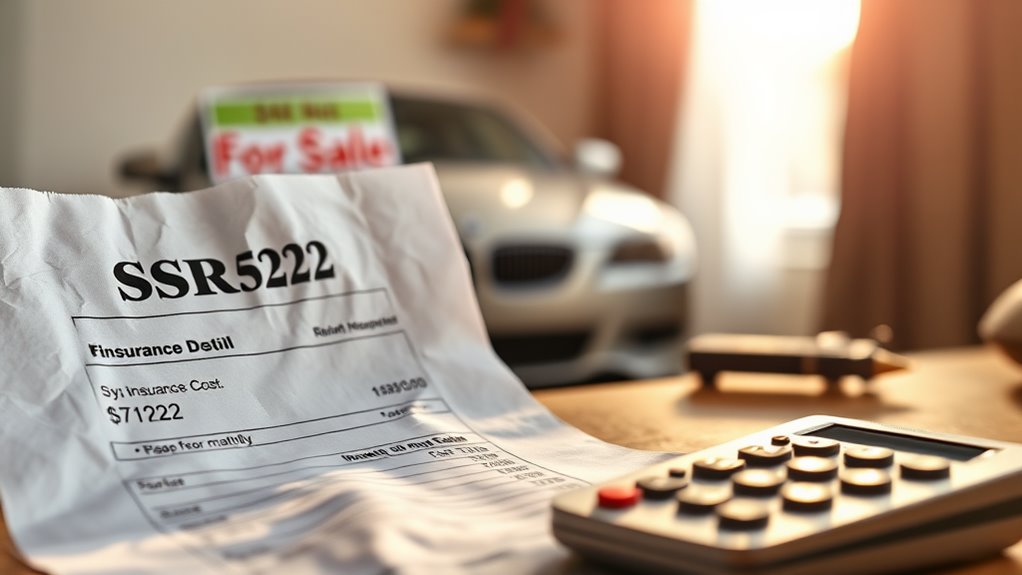Why Is Monthly SR22 Insurance so Expensive?
If you've ever wondered why monthly SR-22 insurance is so expensive, you're not alone. Many drivers find themselves facing steep premiums after being classified as high-risk due to serious offenses like DUIs. Factors such as vehicle type, location, and credit score further complicate the cost. With SR-22 requirements lasting several years, it's crucial to understand all the elements contributing to this financial burden. What other factors might be at play in your specific situation?
How does having an SR-22 affect your monthly insurance costs? When you're required to file an SR-22, you're fundamentally classified as a high-risk driver, which can lead to remarkably higher insurance premiums. An SR-22 isn't a type of insurance; it's a certificate of financial responsibility that verifies you meet your state's minimum liability insurance coverage. While the SR-22 filing itself may only cost between $15 and $50, the true financial impact comes from the increased monthly insurance rates that follow.
Your driving history plays a critical role in determining how much you'll pay each month. If you've had serious offenses, like DUI or reckless driving, you can expect to face steep premiums. It's not just your past actions that matter, though; the type and age of your vehicle also come into play. Newer cars typically come with higher insurance costs, which can compound the financial burden of having an SR-22.
Additionally, where you live matters greatly; states like California tend to have higher average SR-22 rates compared to others, making geography a key factor in your insurance expenses. It's also important to be aware that SR-22 requirements can vary significantly from state to state, impacting both the duration and the cost of coverage.
Another aspect to reflect on is the level of coverage you choose. Maintaining minimum legal requirements might save you some money, but it also leaves you exposed to potential financial pitfalls. If you decide to increase your coverage limits for better protection, be prepared for those costs to rise considerably. Your credit score can't be ignored either; a good score could help lower your monthly premiums by a notable margin, while a poor score can lead to higher costs.
State variations add another layer of complexity. Some states impose additional fees for reinstating driving privileges, which can affect your overall expenses. Plus, SR-22 requirements often last for several years, meaning you'll need to budget for those elevated rates over an extended period. It's not uncommon for drivers to feel trapped in this cycle of high premiums.
To mitigate these costs, think about adjusting your policy. Increasing deductibles can often lower your monthly premium, making the insurance more manageable. Combining different types of insurance, like car and renter's insurance, can also yield discounts. Regularly reviewing your policies as circumstances change allows you to make adjustments that can lead to savings.
Shopping around for quotes is vital as well. By comparing offers from various insurers, you can identify the best rates available to you. Taking a defensive driving course might also demonstrate your commitment to safer driving, potentially lowering your premiums. Additionally, if you don't own a vehicle, exploring non-owner SR-22 policies may present a cheaper alternative.
Ultimately, having an SR-22 requirement typically results in increased rates, reflecting the underlying driving offenses rather than the SR-22 itself. Once you fulfill the SR-22 requirement, you may notice a drop in your insurance costs, but until then, understanding the factors that influence your rates can help you navigate this challenging financial landscape.
Conclusion
To summarize, the high costs of monthly SR-22 insurance can feel like being trapped in a financial black hole. Factors such as your driving history, vehicle type, and location all contribute to these inflated premiums. Unfortunately, the high-risk designation associated with SR-22 filings means you'll likely face these expenses for years. To mitigate the burden, it's important to shop around for the best rates and consider safe driving practices to help lower your risk profile over time.
